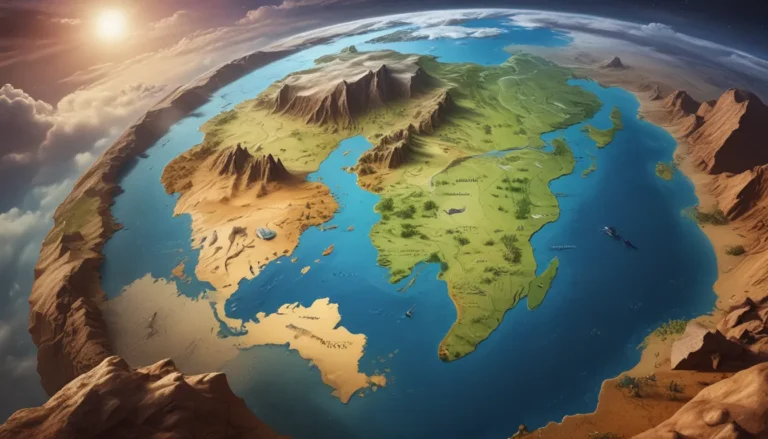A Note About Images: The images used in our articles are for illustration purposes only and may not exactly match the content. They are meant to engage readers, but the text should be relied upon for accurate information.
Have you ever stopped to consider the intricate dance of people, goods, and ideas within geographical spaces? Spatial interaction is a captivating concept that shapes our world in profound ways, influencing everything from urban planning to economic patterns. While the idea of spatial interaction may seem familiar, there are numerous surprising and lesser-known facts that offer a deeper understanding of this phenomenon. Join us as we uncover 20 surprising facts about spatial interaction, igniting your curiosity and illuminating the interconnectedness of humans and their environment.
Understanding the Essence of Spatial Interaction
At its core, spatial interaction is the flow of goods, people, information, and ideas between different locations. This exchange of resources not only shapes the interconnectedness of our world but also influences the dynamics of societies, cultural diffusion, and development.
Tracing the Roots of Spatial Interaction
The concept of spatial interaction can be traced back to the early 20th century when geographers and transportation planners began studying patterns of movement and connectivity. Over time, the field has evolved, incorporating technological advancements and communication developments.
Unveiling the Power of Gravity Models
To analyze and predict spatial interaction, experts often rely on gravity models. These models leverage the principle of gravitation to estimate the likelihood and intensity of interactions between locations based on factors like distance, population, and economic activity.
Embracing the Diversity of Spatial Interaction
While physical movement is a prominent form of spatial interaction, the concept extends beyond transportation to encompass virtual interactions through telecommunications and the internet. This digital connectivity has revolutionized global communication, shaping the way we connect with others.
Impact on Urban Planning and Development
Spatial interaction significantly influences urban planning, enabling city planners to optimize transportation networks, strategically locate amenities, and improve accessibility for residents. This understanding contributes to efficient land use and sustainable urban development.
Bridging Disciplines Beyond Geography
Beyond geography, spatial interaction is relevant in fields such as economics, sociology, and political science. By examining spatial interaction, experts gain insights into market dynamics, social networks, and political relationships, highlighting the interconnected nature of various phenomena.
Shaping Global Trade and Economic Systems
The flow of goods within spatial interaction directly impacts global trade and economic systems. The movement of commodities between countries influences industry distribution and the competitiveness of nations on the global stage.
Exploring Varied Dimensions of Spatial Interaction
From migration patterns to disease spread, spatial interaction plays a pivotal role in shaping various aspects of society. Understanding these dimensions offers valuable insights into human behavior and societal trends.
Impact on Migration Patterns
The decisions individuals make to relocate are often influenced by factors like job opportunities, quality of life, and cultural attractions. Analyzing spatial interaction patterns helps us understand these migration trends and their implications on population distribution.
Role in Disease Spread
The movement of people, particularly in densely populated areas, can accelerate the transmission of infectious diseases. By studying spatial interaction patterns, experts can model and manage disease outbreaks more effectively.
Influence of Transportation Infrastructure
The development of transportation infrastructure, including roads, railways, airports, and ports, has transformed the movement of goods and people across long distances. These advancements have connected regions, boosted economies, and fostered cultural exchange.
Adapting to Technological Advancements
In a rapidly evolving technological landscape, spatial interaction continues to adapt and expand. Innovations like drones for delivery and hyperloop systems for high-speed transportation hold the potential to revolutionize spatial interaction in the future.
Revolutionizing Cultural Diffusion
As people, goods, and ideas move between locations, cultural traits and practices can spread, shaping local cultures. This process of cultural diffusion contributes to the diversity and evolution of societies.
Understanding Economic Factors
Economic factors such as supply and demand play a pivotal role in driving spatial interactions. Businesses and policymakers must grasp these economic influences to make informed decisions that maximize opportunities and efficiencies.
Embracing the Impact of Natural Disasters
Events like natural disasters and climate change can disrupt transportation networks and impede spatial interaction. Understanding these risks is essential for disaster preparedness and resilience planning.
Promoting Sustainable Development
The movement of goods and people within spatial interaction can have environmental implications, contributing to pollution, carbon emissions, and habitat destruction. Sustainable spatial planning aims to minimize these impacts and promote eco-friendly transportation solutions.
Addressing Regional Disparities
The study of spatial interaction sheds light on regional disparities and social inequalities, informing interventions and policies to promote equitable development. By examining interaction patterns, we can identify areas in need of support and targeted interventions.
Embracing Ongoing Advancements
As technology and globalization continue to shape our world, spatial interaction will evolve in tandem. This evolution will redefine the future of transportation, communication, and global connectivity, offering new opportunities and challenges.
Conclusion: Navigating the Intricacies of Spatial Interaction
In conclusion, spatial interaction is a compelling force that shapes our world in profound ways. From the movement of people and goods to the exchange of information and ideas, spatial interaction influences every facet of our daily lives. By unraveling the complexities of this phenomenon and studying its patterns, we gain invaluable insights into human behavior and societal dynamics. Let us continue to explore the intricacies of spatial interaction, fostering a deeper understanding of our interconnected world.
FAQs
-
What is spatial interaction?
Spatial interaction refers to the flow or movement of people, goods, information, and ideas between different locations, shaping economic, social, and cultural patterns. -
What factors influence spatial interaction?
Factors such as distance, transportation infrastructure, cultural barriers, economic conditions, and government policies influence spatial interaction, either facilitating or constraining movement and exchange. -
How does transportation affect spatial interaction?
Transportation systems play a significant role in facilitating spatial interaction by enhancing accessibility and reducing travel time, promoting the movement of people, goods, and information. -
Can cultural factors influence spatial interaction?
Yes, cultural factors such as language, customs, and social norms can influence spatial interaction by shaping the flow of people, ideas, and goods between regions. -
Why is studying spatial interaction important?
Studying spatial interaction is crucial for understanding human behavior, urban planning, market analysis, and policy-making, leading to more efficient and sustainable development.
As we continue to delve into the depths of spatial interaction, let us embrace the complexities and nuances that shape our interconnected world. Together, let us unravel the mysteries and embrace the opportunities that spatial interaction offers, guiding us towards a more sustainable and harmonious future.






